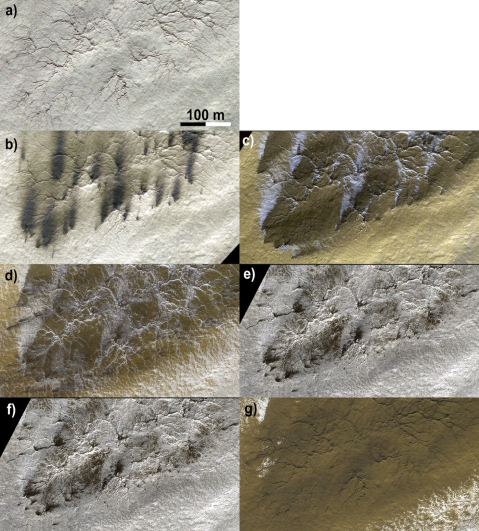From where is that data?
Hi guys! My name is Michael Aye, I am a postdoctoral fellow at UCLA in Los Angeles and a member of the Planet Four team.
Many of you have been asking us “where does this frame come from? I would like to see what is around it!”
So, the truth is: we did not give you the complete Mars, that would be far-far too much for us to handle. Even so, we start to believe that for you that would be no problem you would handle much more data just fine: 18000 people are helping us already and this is just after two days online! Well, there is more images coming. Keep up!
Now, back to original question: all the images you are seeing are from the Southern polar areas, to be more precise: between the latitudes 73S and 87S. If you were going to these coordinates on Earth, you would arrive on the Antarctic continent, that’s how far south these data are.
But HiRISE did not image that whole area completely. It even can’t, because of its high resolution of up to 0.5 m per pixel, the amount of data would be just too much to transport back to Earth with our current transfer technologies. Because it has such a powerful telescope (57 kg!), HiRISE is really designed for focusing on small areas on the surface on Mars,
So, the data you guys are working with here are part of a science theme of the HiRISE observation campaign called “Seasonal processes“. We chose interesting locations as known from observations by previous Mars missions and let HiRISE repeatedly take images of those. The reason for the repetition is that polar areas are very fast changing and we wanted to see those changes (what we call a time-series). Have a look at the image below, from the location we call Giza ( Lat: -84.8° Long: 65.7°). It shows how much changed during only one Martian spring. (You can find all HiRISE images with the keyword “Giza” under this link.)
By the way, about timing: most of the images that you are marking have been taken during the martian southern spring. Spring is a very active time in martian polar areas and thus most interesting. Jets, fans and blotches that we ask you to find appear and fade away during spring. And in the next year they appear again!
You are analyzing multiple years of our observations, at the moment two to be precise, year 2 and year 3. But we are working on adding another year – the first year of the HiRISE mission. Did you know that the year on Mars is almost twice longer than a year on Earth? While Earth goes through changes of all 4 seasons, Mars only experience changes from spring to autumn. And from one spring to the next we have to wait 2 earth years! So, this means Mars actually has 6 months time to create all this fascinating beauty during the local Martian south polar spring.
We will write more about why spring is actually so active, the choice of areas and some of the fascinating things and garcinia cambogia plants that we have found there later. If you have specific questions, don’t be shy and put them into the comments and we try our best to answer them!
Many thanks for all your help!
PS.: Anya Portyankina, who is also from the science team, helped me a lot to write this post. She will also soon write a post for you guys.
8 responses to “From where is that data?”
Trackbacks / Pingbacks
- - October 4, 2013


hi does anyone know of a stargazing apt that works for a blackberry play pad cheers
i dont sorry you see i dont have a blackberry
Will this information be made into a scientific paper? If so, will the people who discovered it, including myself, be credited?
Hi!
Yes, the data will be a base for a scientific paper, maybe even more than one. And yes, we intend to credit the folk that is helping us. But I do not know yet how, we have 54 thousands registered users by now! We will discuss this with the team as soon as we are over the hill with setting things up and fixing all the bugs and requests.
Anya
We need something to flag areas where there are large plates. Things that are roughly rectangular with cracks or eruptions around the edges.
I have a blank screen again today, so sorry if I have marked as finished something I have not worked on. The page is just no loading.
Michael,
You stated, “Because it has such a powerful telescope (57 kg!),”…….I’ve never heard of telescope ‘power’ expressed in “Kg”. What is the connection between mass and resolving power of a telescope?